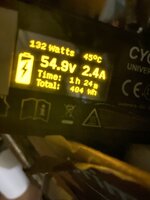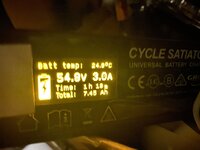Oski1997
Active Member
- Region
- USA
- City
- San Diego
Ebiker01, Yamaha says it takes 2 hours to charge form 75% to 100%. Does that mean that theoretically (using your math) the Yamaha battery should be able to be charged from 0% to 75% in 1.47 hours?Has to do with the charger wattage , amps and battery amps.
Assuming the 500wh battery is 36volts . 500:36= 13.8ah. 13.8ah:4ah(charger amps)= 3.47hours.
If the Grin Satator charger would work on this battery you could have charge at 6.8ah w/o any issues ! Even @8ah the max. rate that the Satiator works.
The reason that charge rate is closer to 4hours and not 3.47h it's due to the slower cycle in the last 25% portion of charging.
It is common in the Ev sector to amplify either the range or the charging times in order to entice customers.
Last edited:

